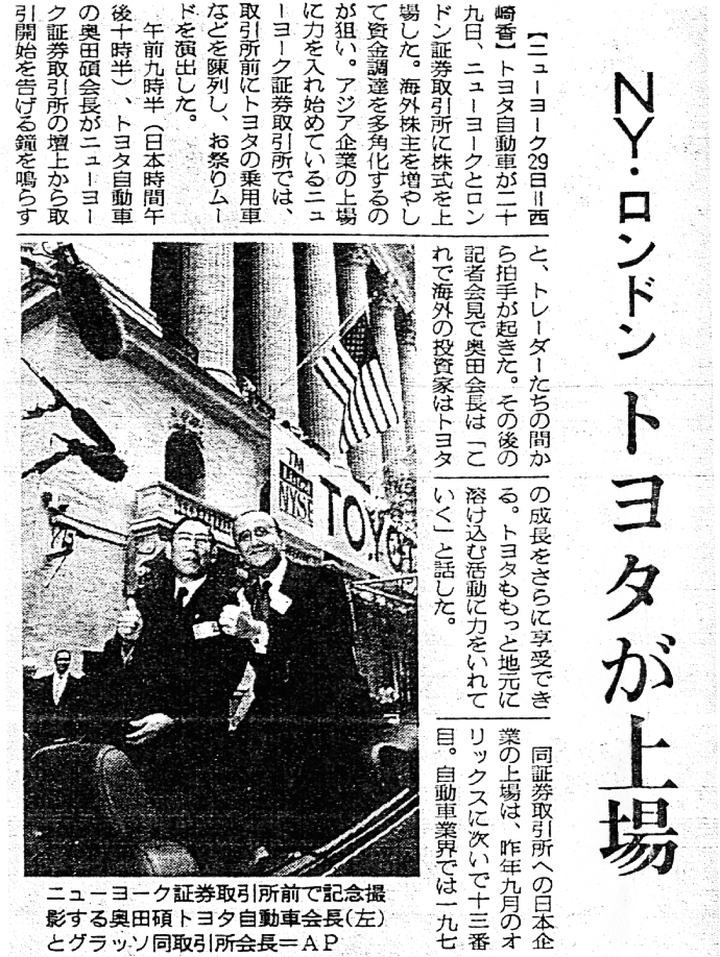Section 7. The Functions that Supported Globalization
Item 5. Global Initiatives in Management Groups
Toward consolidated management that highly values stakeholders
In September 1999, TMC's stock was listed on both the New York Stock Exchange and the London Stock Exchange. The main reasons for taking this action were raising funds outside Japan and improving Toyota's name recognition and brand image. The move was to serve as motivation for pursuing a management style suitable to stock markets, which included increasing management transparency, strengthening earning power, and improving investment efficiency.
Meanwhile, in the United States, the Public Company Accounting Reform and Investor Protection Act (also known as the "Sarbanes-Oxley Act of 2002") was enacted in July 2002 in response to the uncovering of a series of instances of large-scale accounting fraud by large corporations. In April 2006, TMC also became subject to this law. To deal with this situation, TMC in January 2005 created the Global Audit Department as an independent organization under direct executive vice president supervision, with the Audit Group in the Accounting Division as the parent body. The Global Audit Department then began taking actions to evaluate and improve the validity of internal control related to consolidated financial reporting.
Fiscal year 1999 (ended March 2000) began with the so-called "Big Bang" accounting reforms in Japan, and listing TMC stock on the two major overseas stock exchanges (New York and London) the same year was timely. The massive reforms were intended to bring the accounting standards in Japan closer to international standards by introducing tax effect accounting, etc. For its part, TMC began publishing public announcements (with a focus on consolidated financial statements) beginning with fiscal year 1999 (ended March 2000) in order to disclose its global financial results.
Furthermore, in 2000, TMC changed the unit of trading its stocks from 1,000 to 100 shares. At the time, financial institutions that were forced to dispose of non-performing loans were selling off shares they held in operating companies, accelerating the dissolution of mutual stockholding arrangements. The listing in overseas stock exchanges and reducing the unit of trading were measures TMC took to counter the loss of stable shareholders caused by the dissolution of mutual stockholding arrangements and to increase the number of individual stockholders.
At the same time, TMC also positioned redistribution of profits to shareholders (for example, through stable dividends) as an important management policy. As part of this policy, TMC also focused on acquiring treasury stock, which leads to improved capital efficiency, and planned to acquire 600 billion yen worth in fiscal year 2002 (ended March 2003), the largest ever for a Japanese corporation. As for dividends, TMC announced a plan to increase the consolidated dividend payout ratio for the medium/long-term to 30 percent beginning in fiscal year 2005, and steadily increased the payout ratio until the fiscal year 2007; immediately after which the global financial crisis, symbolized in the collapse of Lehman Brothers, set in.
In promoting stakeholder-oriented consolidated management, TMC introduced its Global Master Plan for developing a five-year management plan on a global scale starting in 2003. This plan-which included product and business planning, profit planning, and management resource allocation planning-clearly identified management-related issues and what needed to be done to ensure profitability, and set goals every other year for the following five years. Furthermore, beginning in fiscal year 2005, TMC introduced Global Profit Management, a framework for achieving annual profit goals and other financial targets, based on the Global Master Plan. As a result, the various functions at TMC were aligned with those of subsidiaries outside Japan, fully establishing a structure for promoting profit improvement activities.


